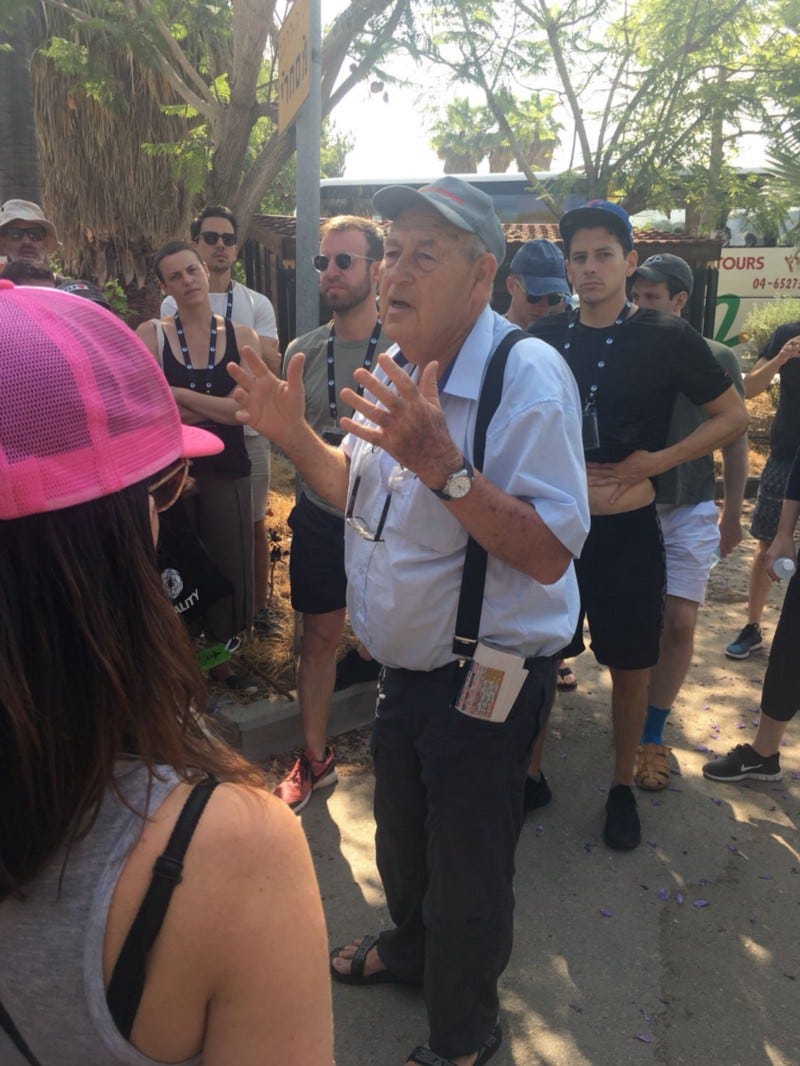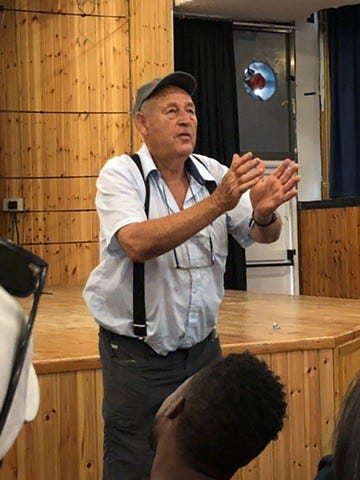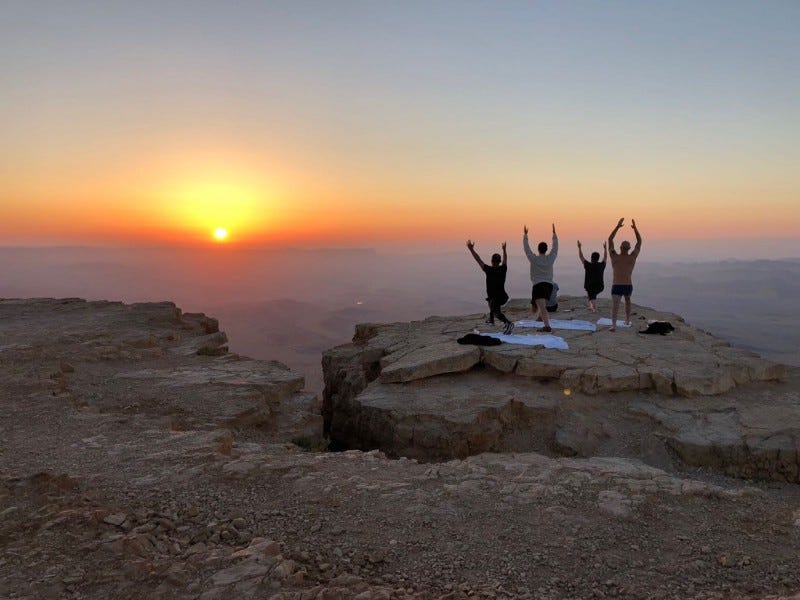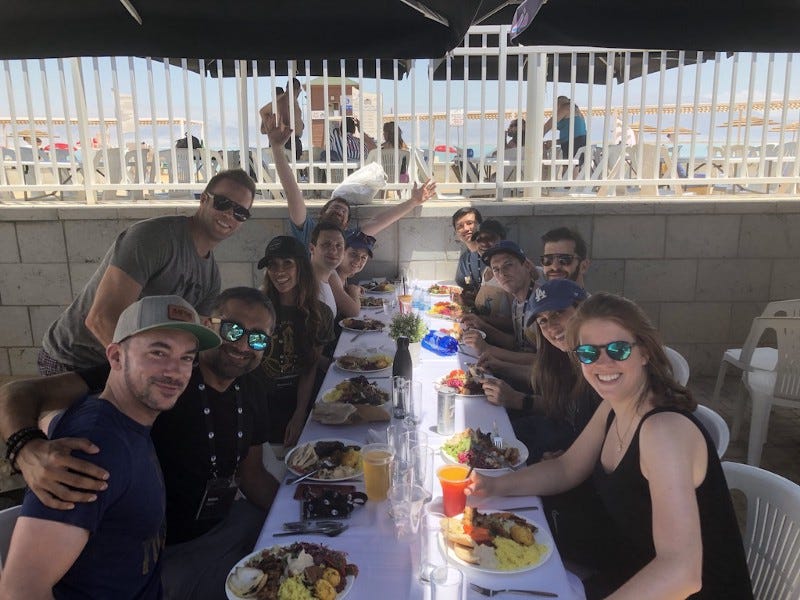Can Shared Living Save Our Cities?
I didn’t expect to see the future of cities when I visited an Israeli kibbutz. Honestly, I was expecting banana farmers and goat herders…

I’ve lived in Boston, New York City and LA. But I didn’t understand the future of cities until I spent time on a tiny kibbutz.
About 100,000 Israelis live in kibbutzim. The kibbutz movement began as socialist farm collectives in the 1940s, rejecting capitalism and creating egalitarian societies based on Marxist principles.
This past May I visited Kibbutz Ma’agan Michael as part of a REALITY Israel journey. The kibbutz is located in northern Israel between Tel Aviv and Haifa. It was started in 1949 as an independent settlement of Israeli farmers.
Today, Ma’agan Michael has a population of 1,400 members (“kibbutzniks”). They grow avocados and bananas, raise fish and produce milk and poultry.

I was fascinated by kibbutz life. Why would someone choose to live in a bubble, away from mainstream society?
We got a tour of Ma’agan Michael from one of the kibbutz leaders (an elderly gentleman who couldn’t have been sweeter or more charming).
I began to understand how a kibbutz can function effectively without money, by using the 4 elements of building a stable community:
Identity
Trust
Participation
Reward
Identity
A good community brings together a group with a shared perspective on a subject or problem. It reflects a specific identity people share.
The kibbutz follows 3 fundamental principles: Equal income to everyone, equal education to everyone, and the best healthcare they can afford.
At Ma’agan Michael, everyone’s clothes are washed together in a central location. Our guide talked about their “collective underwear” (still not sure if this was a joke).
For Jewish holidays, kibbutz members gather together for prayer services in a former bomb shelter.
Creating a strong sense of purpose and belonging is a big part of life on the kibbutz.
As our guide said:
“The kids today, all of them come back. Why? They say, I don’t mind that we’re all equal…it’s my home here, with all my brothers and sisters. Money isn’t so important for me. My priority is my family — that’s how I grew up.”
Trust
Ma’agan Michael has boards to regulate education, healthcare and labor.
People new to the kibbutz get a budget of one year to get started.
All kibbutzniks must work a job to earn their keep. Those who take a job in the outside world is required to bring in a salary of 8000 shekels a month. Teachers and social workers only need to bring in 6000 shekels.
The Plasson factory generates 70% of the kibbutz’s income. The job of factory manager has a term limit of 8 years:
“At the time, Bill Clinton had finished his 8 years, and we said if Bill Clinton can only do 8 years…you should know that Bill Clinton is very much admired here. People really liked him, he was a very lovable person.”
Kibbutzniks are free to meet romantic partners from outside the kibbutz:
“Usually people from the same kibbutz don’t get married. It happens, but usually with people you’ve known all your life, you don’t fall in love. They don’t become prettier or better.”
Participation
One of the biggest challenges of running a Kibbutz is “shirking” — what economists refer to as the problem of incentives. Parasites who feed off of the hard work of others.
Kibbutz Ma’agan Michael recognized there was a problem when they saw all the fat cats.
“Our cats today look normal. But before, they were really fat. Why? Because people took home extra schnitzels, because it was free! So cheese for the cats, steaks for the dogs — a lot of fun.”
So they decided to change the system. They privatized the dining room. Kibbutz members today get extra money for food, and can decide whether to buy a meal there or shop in the local grocery and cook at home.
“We started to charge for every loaf of bread. The quantity of bread reduced by 50 percent. Bread was not thrown away anymore. And the schnitzel — before, people used to bring a bag and put schnitzels in. The cat couldn’t eat it all.”
Reward
People must get value from participation in the community — either intrinsic value (i.e. good feelings) or extrinsic value (knowledge, money).
In place of money, the kibbutz uses intrinsic rewards to motivate people to participate. Making people feel connected to something larger than themselves. Feeling they have a sense of freedom, accomplishment and autonomy:
“The factory manager works 20 hours a day and gets the same salary as everyone else. Here the salary isn’t the main motivation, it’s about to do what you want, to be appreciated, to get the respect of your kids. You come to the dining room on Friday and people say, Oh Gilad, and they always remember how he’s working his ass off.”
I learned how the kibbutz uses public shaming to punish bad behavior and deter shirking:
“In the community we have shaming. You want to be appreciated in the community, your kids to look up to you. Some people complain others aren’t working as hard. They say, I work 15 hours a day, and the guy next to me, I see him in pajamas at 10 o’clock in the morning, it’s not fair!
We have some schmucks who take advantage of the system. Lazy people in the new generation who don’t always want to work. Old timers say, how many people here are lazy? 5 percent? For 5 schmucks, should we change the system? Those 5 schmucks, sometimes they don’t have a choice.
The shaming still works, though. How do you shame people? When people go to the dining hall Friday night and you see the guy there, people point and make fun of him.”
What can we learn from kibbutz life? Is there a place for communal living in our era of globalization, individualism, and capitalism?
Consider the low rate of PTSD among Israeli war veterans (1.5% in Israel, 20–30% in the US). Most Israelis today do not live in a kibbutz. Yet the inclusive kibbutz culture extends to other parts of society. War veterans in Israel are embraced and celebrated. Unlike in the United States, there is no person in Israel who is untouched by terrorism or war; soldiers are an integral part of Israeli society.
By contrast, 20 veterans die by suicide in the US every day. In the past 20 years we’ve seen rising mortality rates for white, non-hispanic middle-aged males. The increasing death rates are caused by drug and alcohol poisonings, suicide, and chronic liver diseases and cirrhosis.
Healthcare professionals refer to these as “Deaths of Despair”:
“Self-reported declines in health, mental health, and ability to conduct activities of daily living, and increases in chronic pain and inability to work, as well as clinically measured deteriorations in liver function, all point to growing distress in this population.”
Loneliness and social isolation in the US have reached epidemic levels. Research on social media interactions has shown that loneliness is more pervasive in societies and age groups where social media usage is the highest.
The American Psychological Association published a paper last year calling for social connection to become a public health priority in the United States.

Sebastian Junger, in his book “Tribe,” argues this lack of connection is what’s causing high suicide rates, mass shootings, high depression, anxiety, child abuse, drug and alcohol abuse, and porn addiction:
“The common denominator in all those things is the catastrophic lack of communal connection that many Americans experience. We should recognize that by shrinking our network of strong social ties to our immediate families, we lose something important to our health and social identities, with the predictable result that we are ridden with anxiety and loneliness. We are meant to have tribes, to be among people who know us and care about us.”
Brene Brown says we are neuro-biologically hard-wired for belonging and connection:
“We are hard-wired to want it and need it so much, that the first thing we do is sacrifice ourselves and who we are to achieve it. From ancient times, to not be wanted or to not belong to the group or tribe meant death.”

In recent years we’ve seen fresh new approaches to community.
Adam Neumann, the billionaire founder of WeWork, grew up in Israel and spent time living on a kibbutz. He recognized the power of economies built around sharing.
WeLive, the company’s new communal-living company, is betting that more young people will want to live in kibbutz-style shared living spaces. Other startups like Common and Starcity have cropped up, offering single-room living, with shared common space, an affordable and efficient option for young renters.
Gillian Morris, founder and CEO of Hitlist, thinks the trend is just getting started. She created and lives in Gramercy House, a communal space in lower Manhattan that holds breakfasts and dinners, meet-ups for tech entrepreneurs, and concerts.
In her view, there’s power in empowering groups of people to set up their own mini societies where you can share resources for the benefit of the group. She sees young people starting to form more groups based around sharing, with profound effects on society.
While I don’t think we should all join hippie communes, I do think we need to create innovative, new social structures to combat the isolation of modern life. When I lived in New York City, I was surrounded by millions of people yet lonelier than I’d ever been. It’s why I’ve been so fascinated with different ways of building community.
In the words of Brene Brown:
At the very heart of belonging is spirituality. An important tenet of spirituality, across all faiths and belief systems: the belief that we are inextricably connected to each other by something greater than us, and this thing is rooted in love and compassion.


